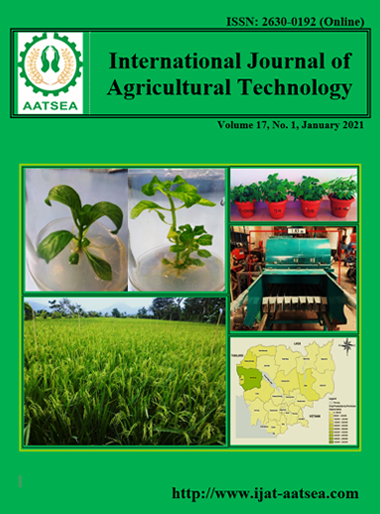Factors affecting farmers’ adoption of good agricultural practice in vegetable production in the upper North of Thailand
Main Article Content
Abstract
Results revealed that ten factors contributed to an increase in the probability that farmers adopted high-level GAP principles and a decrease in the probability that farmers adopt low-or moderate-level GAP principles. These factors include owning capital for GAP vegetable production, borrowing capital for GAP vegetable production, diversity of GAP vegetables, suitable prices, the knowledge provided by private entities on the food safety of GAP vegetables, a positive attitude toward GAP vegetable production, being a member of Bank for Agriculture and Agricultural Cooperatives, being a member of a farmer group, being a member of a community enterprise, and being a member of other interest groups. Meanwhile, the six factors associated with a decreased likelihood that farmers adopt high-level GAP, and a subsequent increased probability that farmers adopted low-or moderate-level GAP included age, education, freshness of GAP produce, knowledge provided by government agencies on the food safety of GAP vegetables, being a member of a village fund, and satisfaction with participation in training on GAP standards
Article Details

This work is licensed under a Creative Commons Attribution-NonCommercial-NoDerivatives 4.0 International License.
References
Al-Amin, A.Q., Masud, M. M., Filho, W. L. and Doberstein, B. (2020). Analysing the socioeconomic and motivational factors affecting the willingness to pay for climate change adaptation in Malaysia. Retrieved from https://doi.org/10.1016/j.ijdrr.2020.101708.
Amerioun, A., Alidadi, A., Zaboli, R. and Sepandi, M. (2018). The data on exploratory factor analysis of factors influencing employees effectiveness for responding to crisis in Iran military hospital. Data in Brief, 1:1-8.
Asteriou, D. and Hall, S. G. (2007). Applied econometrics: A modern approach using EViews and Microfit. Palgrave Macmillan, New York, pp.397.
Damisa, M. A. and Yohanna, M. (2007). Role of Rural Women in Farm Management Decision Making Process: Ordered Probit Analysis. World Journal of Agricultural Sciences, 3:543-546.
Joshi, A., Kalauni, D. and Tiwari, U. (2019). Determinants of awareness of good agricultural practices (GAP) among banana growers in Chitwan, Nepal. Journal of Agriculture and Food Research, 1:1-4.
Kramol, P., Villano, R., Fleming, E. and Kristiansen, P. (2010). Technical efficiency and technology gaps on ‘clean and safe’ vegetable farms in northern Thailand: a comparison of different technologies. The 54th the Australian Agricultural and Resource Economics Society 2010 Conference, University of New England, Adelaide Australia, pp.1-21.
Lanfranchi, M., Schimmenti, E., Campolo, M. G. and Giannetto, C. (2019). The willingness to pay of Sicilian consumers for a wine obtained with sustainable production method: An estimate through an ordered probit sample-selection model. Wine Economics and Policy, 8:203-215.
Larnlua, P. (2017). Model Development for Agricultural Health Product Producers. (Doctoral Dissertation). King Mongkut’s University of Technology North Bangkok, Thailand.
Li, M., Wang, J., Zhao, P., Chen, K. and Wu, L. (2020). Factors affecting the willingness of agricultural green production from the perspective of farmers' perceptions. Retrieved from https://www.sciencedirect.com/science/article/pii/S0048969720338109.
Maneejuk, P. (2018). Ordered Logit and Probit Models. Retrieved from https://mparavee.files.wordpress.com/2018/11/ordered-logit-and-ordered-probit-models.pdf.
Marine, S. C., Martin D. A., Adalja, A., Mathew, S. and Everts, K. L. (2016). Effect of market channel, farm scale, and years in production on midAtlantic vegetable producers' knowledge and implementation of Good Agricultural Practices. Food Control, 59:128-138.
Mingsakul, S. (2015). Knowledge and practice in accordance with good agricultural practice (GAP) of farmers growing vegetables in Mae Rim district, Chiang Mai. (Master Thesis). Maejo University, Thailand.
Ministry of Commerce (MOC) (2018). Export value. Retrieved from http://tradereport.moc.go.th/Menu_Trade.aspx.
National Bureau of Agricultural Commodity and Food Standards (2019). GAP of food. Retrieved from http://e-http://book.acfs.go.th/Book_view/72.
Nicetic, O., Fliert, E., Chien, H. O., Mai, V. and Cuong, L. (2010). Good Agricultural Practice (GAP) as a vehicle for transformation to sustainable citrus production in the Mekong Delta of Vietnam. The 9th European IFSA Symposium, Vienna, pp.1893-1901.
Office of Agricultural Economics (OAE) (2017). Statistic of agricultural and fertilizer chemical. Retrieved from http://www.oae.go.th/view/1/.
Office of Agricultural Economics (OAE) (2018). The study of farmers' readiness in adaptation to technology and innovation case study on rice, cassava and oil palm. Retrieved from http://www3.oae.go.th/zone7/images/research/research60/research60.pdf.
Panplum, P. (2016). Factors Affecting Consumers’ Willingness to Pay for Organic Products in Green Markets and Specialty Health Food Chain Stores in the Bangkok Metropolis and Vicinity. Modern Management Journal, 14:169-178.
Pongvinyoo, P., Yamao, M. and Hosono, K. (2014). Factors Affecting the Implementation of Good Agricultural Practices (GAP) among Coffee Farmers in Chumphon Province, Thailand. American Journal of Rural Development, 2:34-39.
Qiu, Q., Sung, J., Davis, W. and Tchernis. R. (2017). Using spatial factor analysis to measure human development. Journal of Development Economics, 132:130-149.
Serirat, S. (2003). Strategic management and cases. Bangkok, Diamond in Business World, pp. 399.
Sirilerdwimon, R. (2000). Adoptions of vegetable growing technology in the nylon-net house of the farmers in Changwat Kanchanaburi. (Master Thesis). Chiang Mai University, Thailand.
Srisopaporn, S., Jourdain, D., Perret, S. R. and Shivakoti, G. (2015). Adoption and continued participation in a public Good Agricultural Practices program: The case of rice farmers in the Central Plains of Thailand. Technological Forecasting and Social Change, 96:242-253.
Sunthonphan, S. (2009). Farmer's adoption of organic production technology system of mango orchards in Phrao district, Chiang Mai. (Master Thesis). Maejo University, Thailand.
Suwanpingkham, P. (2009). Farmers use of good agricultural practice for toxic substance safe vegetable production in Saraphi District, Chiang Mai Province. (Master Thesis). Chiang Mai University, Thailand.
Taitaemthong, B. (2011). Adoption of Arabica coffee cultivation technology by Miang tea farmers in royal project Extended program at Pag Ma-O village, Mae Na Sub-district, Chiang Dao district Chiang Mai. (Master Thesis). Chiang Mai University, Thailand.
Thai Customs Department (2018). Import value. Retrieved from http://dataservices.mof.go.th/Dataservices/IECountryAndCategory.
Yoon, C., Lim, D. and Park, C. (2020). Factors affecting adoption of smart farms: The case of Korea. Computers in Human Behavior, 108:1-20.
Zeweld, W., Huylenbroeck, G. V., Tesfay, G., Azadi, H. and Speelman, S. (2019). Sustainable agricultural practices, environmental risk mitigation and livelihood improvements: Empirical evidence from Northern Ethiopia. Land Use Policy, 1:1-13.


